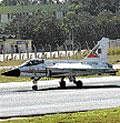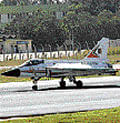

The flight took off from HAL airport at 1 pm and touched an altitude of 9 km and speed of Mach number 0.85, meeting all its initial flight requirements, according to defence sources.
The prototype was flown by Group Captain Ritu Raj Tyagi. Air Commodore Rohit Varma, project director (flight test) flew in the rear cockpit.
A Defence Research Development Organisation release said, “All the objectives set out for the flight were achieved and all the systems on board the new prototype performed well throughout the sortie.”
The release said the successful flight of the trainer was a major milestone for the Tejas programme and a significant achievement for all the stakeholders. According to aeronautical industry sources, the flight of the prototype is proof of the capability of the country’s aircraft design engineers.
With the Tejas scheduled to be cleared for initial operations with the Indian Air Force (IAF) by end 2010, the successful maiden flight of Tejas trainer has given a fillip to the programme.
The trainer, when fully developed, will have the full operational capability from the rear cockpit as well. As the Tejas trainer has a lot of commonality with the Tejas naval version, even Tejas navy programme would see accelerated progress as a result of the successful first flight.
The LCA trainer is a stepping stone for the LCA’s naval variant which requires extra visibility over the nose for the pilot to be able to see as forward as possible as the aircraft would have to land on the flight deck of an aircraft carrier which is far more challenging than landing on a normal runway.
The development of the trainer will help meet the timelines for induction of the LCA into squadron service with the IAF. According to IAF sources, the LCA trainer version will require hundreds of sorties to obtain operational clearance. Only then the IAF pilots can fly it.
At this stage, the IAF’s test pilots will fly the prototype to validate various aerodynamic parameters like basic handling characteristics. This could stretch for over a year during which the speed, altitude, acceleration and ‘G’ envelope would be tested.